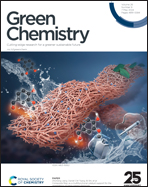Antisolvent effects in green solvent engineering of FA-based quasi-2D Ruddlesden–Popper perovskite films for efficient solar cells†
Abstract
Formamidinium (FA)-based quasi-2D perovskites show attractive potential for use in perovskite solar cells (PSCs) owing to their broad absorption range and high stability. However, the toxic solvents used in their fabrication process hinder their further commercialization. Using a green solvent system to prepare high-quality perovskite films is a crucial step in solar cell manufacturing. Herein, we employed a green solvent triethyl phosphate (TEP) to prepare an FA-based quasi-2D perovskite precursor and studied antisolvent effects by comparing less toxic petroleum ether (PE) and dibutyl ether (DBE). We found that the sample treated with the lower polarity solvent PE produced better perovskite films with larger grain sizes and fewer defects. The advantages of using PE as an antisolvent during film growth and the characterization of their properties are discussed and elucidated. Finally, a champion PCE of 17.42% was obtained with a solar cell configuration of ITO/PTAA/perovskite/PCBM/BCP/Ag, which is the highest value among FA-based quasi-2D PSCs containing perovskite layers fabricated using an all-green solvent system. This work provides a promising way to use an all-green process to fabricate high-performance quasi-2D PSCs in an environment-friendly manner.



 Please wait while we load your content...
Please wait while we load your content...